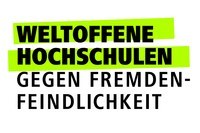| Telefon: | +49 261 287 - 2259 |
| E-Mail: | mhopp(at)uni-koblenz.de |
| Web: | uni-koblenz.de/de/mathematik-n... |

Jun.-Prof. Dr. Marie-T. Hopp
Lebenslauf
Geburtsdatum/-ort | 23.08.1992 in Köln |
09/2003 - 03/2012 | Martin-Butzer-Gymnasium Dierdorf |
04/2012 - 09/2017 | Studium der Fächer Chemie und Biologie (B. Ed. und M. Ed.) an der Universität Koblenz-Landau, Campus Koblenz |
seit 02/2016 | Jurorin beim Wettbewerb "Jugend forscht" in Koblenz und Remagen |
04/2017 - 09/2017 | Masterarbeit am Pharmazeutischen Institut der Universität Bonn bei Prof. Dr. D. Imhof zum Thema "Einfluss von Häm auf Proteine der Blutgerinnungskaskade" |
10/2017 - 06/2021 | Promotionsstudium am Pharmazeutischen Institut der Universität Bonn unter der Leitung von Prof. Dr. D. Imhof |
04/2020 - 03/2023 | Lehrbeauftrage für Biochemie ("Biochemie 1", "Biochemie 2") an der Universität Koblenz-Landau, Campus Koblenz |
06/2021 | Promotion zur Dr. rer. nat. im Fach Pharmazie (Prädikat: summa cum laude/Note: 0,0) zum Thema: "Investigation of the procoagulant role of labile heme under hemolytic conditions" |
07/2021 - 10/2022 | Postdoktorandin in der Pharmazeutischen Biochemie und Bioanalytik an der Universität Bonn |
11/2021 - 10/2022 | Lehrbeauftrage für Biochemie ("Grundlagen der Biochemie und Physiologie") an der Universität Trier |
11/2022 - 03/2023 | DFG-geförderte temporäre Principal Investigator am Pharmazeutischen Institut der Universität Bonn |
seit 04/2023 | Juniorprofessorin (W1) für Organische Chemie – Bioorganische Chemie an der Universität Koblenz |
Auszeichnungen
Jahr | Auszeichnung |
|---|---|
2024 | Reisestipendium der Max-Buchner-Forschungsstiftung |
2024 | FCI Sachkostenzuschuss 2024 |
2023 | Günter Landbeck Excellence Award |
2023 | FCI Sachkostenzuschuss 2023 |
2022 | GTH Early Career Research Grant |
2022 | BAYER Promotionspreis 2021 |
2020 | Argelander Grant |
Mitgliedschaften
Gesellschaft für Biochemie und Molekularbiologie e.V. (GBM)
Gesellschaft für Thrombose- und Hämostaseforschung e.V. (GTH)
Deutscher Hochschulverband (DHV)
Gesellschaft Deutscher Chemiker e.V. (GDCh)
- FREQ-Netzwerk (Female Research Equality)
European Hematology Association (EHA, Guest)
Institut für Medizintechnik und Informationsverarbeitung (MTI) Mittelrhein
Drittmittelprojekte
Mittelgeber: Deutsche Forschungsgemeinschaft (DFG)
Laufzeit: seit 11/2022
Das Metalloporphyrin Häm ist eine Komplexverbindung aus einem zentralen Eisenion und einem Porphyrinringsystem, das als wesentlicher Bestandteil von Hämoproteinen, wie dem Sauerstofftransportprotein Hämoglobin, im Körper weit verbreitet ist. Eine unausgewogene Häm-Homöostase führt zur Freisetzung von Häm, dessen Beseitigung aus der Zirkulation i.d.R. durch mehrere Proteine, wie Hämopexin, reguliert wird. Erhöhte intravaskuläre Häm-Level werden jedoch mit prothrombotischen, zytotoxischen, proinflammatorischen und Komplement-aktivierenden Effekten in Verbindung gebracht, die die schwerwiegenden Komplikationen bei Patient*innen mit hämolytischen Erkrankungen, wie der Sichelzellanämie und transfusionsbedingter Hämolyse, kennzeichnen. In Anbetracht der hohen Prävalenz von Thrombosen und der damit verbundenen Sterblichkeit ist es erstaunlich, dass der Mechanismus der prothrombotischen Wirkungen von labilem Häm auf molekularer Ebene noch nicht vollständig aufgeklärt ist. Bei den in diesem Zusammenhang wichtigsten Proteinen, den Komponenten des Blutgerinnungssystems, sind verschiedene Proteine, darunter Faktor VIII, aktiviertes Protein C und Fibrinogen, als Häm-bindende oder sogar Häm-regulierte Proteine identifiziert worden, während andere (Thrombin, FXIIIa) kein Häm binden. Viele Fragen bezüglich einer möglichen Interaktion von Häm mit dem Großteil der Gerinnungsfaktoren sind noch offen. Dieses Projekt zielt daher darauf ab, die transiente Interaktion von Häm mit dem Gerinnungsfaktor FVIII und von Willebrand-Faktor mithilfe von biophysikalischen (z.B. UV/Vis, SPR) und strukturanalytischen (rRaman) Methoden aufzuklären. Darüber hinaus werden biochemische und hämatologische funktionelle Testsysteme sowie zelluläre Ansätze mit hoher physiologischer Relevanz (z.B. Thrombozyten- und Endothelzellenfunktionsanalyse) durchgeführt. Die gewonnenen Ergebnisse werden in den kausalen Wissensgraphen HemeKG eingearbeitet, um so die bereits bekannten prothrombotischen Effekte von Häm miteinander vernetzen zu können und bisher unbekannte Aspekte des Einflusses von Häm auf die Blutgerinnung herauszuarbeiten. Zusammenfassend werden die prokoagulierenden Wirkungen von Häm auf molekularer, biochemischer, bioinformatischer und zellulärer Ebene mit einer Vielzahl an spektroskopischen Methoden und funktionellen Assays untersucht. Dies wird eine detailliertere Charakterisierung der prothrombotischen Natur von Häm ermöglichen und neue Perspektiven für die Behandlung von Hämolyse-assoziierten Thrombosen schaffen.
Publikationen:
Mubeen, S., Domingo-Fernandez, D., Díaz del Ser, S., Solanki, D., Kodamullil, A. T., Hofmann-Apitius, M., Hopp, M.-T.*, Imhof, D.* (2022) Exploring the complex network of heme-triggered effects on the blood coagulation system. J. Clin. Med. 11(19), 5975.
GTH Early Career Research Grant
Mittelgeber: Gesellschaft für Thrombose- und Hämostaseforschung e.V.
Laufzeit: seit 03/2022
The aim of this project is to provide knowledge about the molecular basis of heme-driven effects on factors of the blood coagulation system in the context of prothrombotic complications in patients suffering from hemolytic disorders.
Argelander-Stipendium für Forschungs- und Outreach-Projekte zur Corona-Pandemie
Mittelgeber: Universität Bonn
Laufzeit: 08/2020 - 10/2021 (15 Monate)
Since the beginning of 2020, the virus SARS-CoV-2 and its associated disease COVID-19 keep the world in suspense. Characterized by pneumonia and inflammation, COVID-19 can also lead to death in the most severe cases. After entry of the virus into the host cell via interaction of its S protein with ACE2, its replication and packaging in the host cell the virus finally enters the blood stream. There, virus particles are present in an even more complex environment with components from the three major regulating systems, the immune, the complement and the coagulation system. Several important clinical parameters, such as the values for hemoglobin and albumin, or inflammation markers are thus changed in COVID-19 patients. Interestingly, the same changes are monitored in hemolytic conditions, which, in addition, are accompanied by an excess of released heme. Inspired by our recent preliminary results, the aim of this project is to analyze the potential link between labile heme and COVID- 19 pathophysiology in more detail. Two approaches are to be pursued for this purpose. On the one hand, a potential binding of heme to selected COVID-19-relevant proteins, namely ACE2, protein 7a, S protein and TMPRSS2, will be characterized by in vitro binding studies, such as via UV/Vis and SPR spectroscopy, as well as by in silico approaches. On the other hand, the potential correlation of COVID-19 infection and labile heme will be further investigated with the incorporation of new clinical data in the recently published COVID-19 knowledge graph, which will allow for a more detailed characterization of the potential relationship between COVID-19 and heme pathophysiology. In the future, information gained from these two approaches may help to understand criteria, which lead to COVID-19 depending on the pre(existing) conditions and clinical background of the patients, while others are not affected. This, in turn, will specifically support diagnostics and treatment options for SARS-CoV-2 infections.
Publikationen:
Hopp, M.-T., Domingo-Fernández, D., Gadiya, Y., Detzel, M. S., Graf, R., Schmalohr, B. F., Graf, R., Kodamullil, A. T., Imhof, D., Hofmann-Apitius, M. (2021) Linking COVID-19 and heme-driven pathophysiologies: A combined computational-experimental approach. Biomolecules 11(5), 644.
Hopp, M.-T., Rathod, D. C., Imhof, D. (2022) Host and viral proteins involved in SARS-CoV-2 infection differentially bind heme. Protein Sci. 31(11), e4451.
Hopp, M.-T., Imhof, D. (2023) Häm-Interaktionen an der Schnittstelle zwischen SARS-CoV-2 und Wirtszelle. BIOspektrum 06.23, 625-628.
Abschlussarbeiten
2024 |
|
Lebenslauf
Geburtsdatum/-ort | 23.08.1992 in Köln |
09/2003 - 03/2012 | Martin-Butzer-Gymnasium Dierdorf |
04/2012 - 09/2017 | Studium der Fächer Chemie und Biologie (B. Ed. und M. Ed.) an der Universität Koblenz-Landau, Campus Koblenz |
seit 02/2016 | Jurorin beim Wettbewerb "Jugend forscht" in Koblenz und Remagen |
04/2017 - 09/2017 | Masterarbeit am Pharmazeutischen Institut der Universität Bonn bei Prof. Dr. D. Imhof zum Thema "Einfluss von Häm auf Proteine der Blutgerinnungskaskade" |
10/2017 - 06/2021 | Promotionsstudium am Pharmazeutischen Institut der Universität Bonn unter der Leitung von Prof. Dr. D. Imhof |
04/2020 - 03/2023 | Lehrbeauftrage für Biochemie ("Biochemie 1", "Biochemie 2") an der Universität Koblenz-Landau, Campus Koblenz |
06/2021 | Promotion zur Dr. rer. nat. im Fach Pharmazie (Prädikat: summa cum laude/Note: 0,0) zum Thema: "Investigation of the procoagulant role of labile heme under hemolytic conditions" |
07/2021 - 10/2022 | Postdoktorandin in der Pharmazeutischen Biochemie und Bioanalytik an der Universität Bonn |
11/2021 - 10/2022 | Lehrbeauftrage für Biochemie ("Grundlagen der Biochemie und Physiologie") an der Universität Trier |
11/2022 - 03/2023 | DFG-geförderte temporäre Principal Investigator am Pharmazeutischen Institut der Universität Bonn |
seit 04/2023 | Juniorprofessorin (W1) für Organische Chemie – Bioorganische Chemie an der Universität Koblenz |





